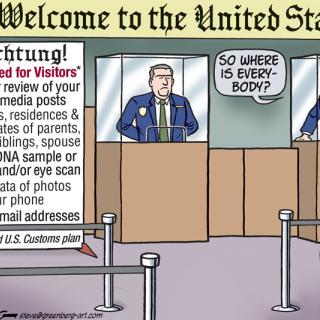While adapting to retirement and finding conditions in the University District more intolerable than at any time in 18 years of homeownership in a historic district abandoned by its city and its adjacent mega-university, during the past 15 months I have become a student of Columbus and a democratic activist. In developer-dominated Columbus, the University District has been sold and bought with the unhesitant approval of the legal and public guardians. In the process, I am known as a “civic leader” in City Hall, I am told, and also told “your name is mud” in Ohio State University’s Bricker Hall administration building. I began writing my regular “Busting Myths” column for the Columbus Free Press. At the same time, I am banned from the Opinion page of the Columbus Dispatch for calling it “muddled and uninformed” on its readers’ comments website. I have the ears and eyes of some in Columbus city government and the media as well as across the community. I have made more new friends and acquaintances than enemies—so far.
In many ways, my lived experience prepared me for this round of my life. Growing up in Pittsburgh, I attended college in Chicago and graduate school in Toronto. I then taught in Dallas and San Antonio before accepting an endowed professorship at Ohio State in 2004. A lifelong resident of large cities, I also taught the history of cities and published books and articles about them. Columbus is both similar to and different than its usually unidentified aspirational peers, including the more attractive and better-served by their institutions, Cleveland and Cincinnati.
Having supervised student research on the neglected history of Columbus, especially by Ellen Manovich on Columbus’ and other cities’ university districts, and talked extensively with geographer Kevin Cox, author of Boomtown Columbus: Ohio’s Sunbelt City and How Developers Got Their Way (2021)—surprisingly the only major, documented book on the city—I tell a complicated and confusing set of intersecting tales. I am still learning facts and drawing lessons.
More than 14 months ago, one of City Council’s best legislative aides came to my house to explain to me how to negotiate and communicate with City Council. She affirmed that no one could communicate with Council or City departments based on Columbus’ chaotic website. Over almost two decades of residence, I learned that the city’s print and broadcast media were at best only occasional assets in that effort.
Three exceptionally intelligent, civic-minded, and helpful young legislative aides guided my steps to navigate and then communicate with the City. They responded to my questions and suggestions, whereas their peers, the City Councilors, and the mayor’s office did not even acknowledge my citizen’s emails. They exchanged lengthy, knowledgeable posts on point and also requested my input. Two came to my home to converse in detail and get acquainted over coffee. Unfortunately, two left the City by fall, a regular in-and-out rotation that reduces both knowledge and continuity in key positions.
Policing
My first areas of concern were lack of gun safety and control, and police response to crime and citizens’ calls for assistance. This was the time of the 2021 ChittFest riot following OSU’s annual Spring Football practice game, an accompanying huge student and outsider event, well known to the authorities. That year’s crowds and festivities were larger than usual, an easily observable phenomenon. Despite dozens of 911 calls about out-of-control partying, violations and violence, and overturned cars, Columbus Police did not respond until more than five hours after the first requests for aid. They trickled in after the crowds began to disperse. In lieu of the necessary investigation, the police pointed vaguely to an unannounced new policy of non-aggressive response. This followed from the outpouring of criticism and lawsuits after CPD’s response to lawful public protests after the Minneapolis Police murder of George Floyd in May-June 2020.
Littering
A second area of concern was, and is, the littering of city streets, sidewalks, and private property by rented electronic scooters that are abandoned willy-nilly, especially in my neighborhood. I was told that “we are beginning to look into it,” with an eye toward developing a policy to regulate both scooters and rental bicycles. There seemed to be a dim awareness that a problem existed.
Aware that other cities were enacting policies responsible to both residents in neighborhoods and others on the roads, I asked if Columbus was studying them. The now-familiar response on all issues: Oh, can you tell us what they are doing? With no city manager and no offices of research and policy in the deeply disconnected bowels of government, this question was neither asked nor answered. I sent information on a number of cities and later updates. Almost 14 months later, nothing has happened. The problems worsen.
Guns
The mayor, who seems to know remarkably little about his city, joins with City Councilors and Columbus Public Health Department in imagining that declaring gun violence “a public health crisis” and organizing after-school basketball games for teens confronts nationally high rates of homicides, including fatal police shootings of Blacks. Little is said about broader social reform, re-staffing, reorganizing, or retraining the police department. At the same, the City offers 100 officers $200,000 buyouts to retire, further reducing its already inadequate numbers, instead of accelerating hiring or undertaking proven gun buy-backs, among many other possible actions.
Representative government
I began to raise questions about the lack of representative government, the missing manager and relevant expertise, the absence of regular meaningful communications, and the opaqueness and disorganization I found at every turn. Aides generally agree with me. The well-paid, part-time City Councilors never address these compelling issues.
OSU/University District crime
My involvement accelerated in August and September 2021 with the overlapping occurrence of a relatively minor increase in crime in off-campus areas, start of the fall semester, and beginning of football season. OSU’s administration completely mismanaged the minor shift in incidence of offenses on- and off-campus. They exaggerated a change that reflected the larger city, confused matters at every turn, and alarmed both students and their parents.
The president spouted slogans but took no meaningful action. The university Office of Campus Safety proved inadequate to its tasks, eventually all but giving up. OSU literally bullied one city Public Safety staff person to ignore procedures and allow the installation of the president’s physical slogans of portable lamp posts and part-time Buckeye Block Watches, as if crime marched to their Wednesday-to-Saturday-evening beat. We await details of the promised ten–year, $20 million safety plan and private security.
Despite the president’s unfounded claims, the portable lamp posts did more harm than good. The short-term, unprofessional Buckeye Block Watch was another directionless spurt of sloganeering that disappeared. Columbus City Police’s touted extra patrolling translated into groups of officers standing together by their bicycles under a street light or sitting in a motionless patrol car for hours. Students did not feel safer. In time, OSU gave up their practice of issuing safety alerts. They were not up to that task.
As winter 2021 turned into spring 2022, a small group of University District homeowners continued to demand responsibility and promised action from the City, CPD, OSU, and the University District landlords. In almost all respects, we are still waiting. At the advice of the former Northern District CPD commander, I initiated an Internal Affairs investigation into police nonresponsiveness and ignorance in the area. I also brought an Assistant City Attorney and OSU Student Life Associate Vice President together in my home.
Further reading
“Columbus’ identity crisis and its media”
“The decline of a once vital neighborhood: Columbus’ University District”
“For Ohio State, bigger is not better”
“Columbus’ University District: Students and the institutions that fail them”
“Notes on current politics in Columbus and Ohio: Thoughts in response to questions from my editor”
“OSU isn’t having a crime crisis; it’s having a leadership crisis”
“‘Update’ to Ohio State isn’t having a crime crisis”
“Columbus city government is undemocratic and disorganized: It’s 2021 and we need a revolution”
“The Ohio State University promotes public health crises”
“Columbus searches for its Downtown with historical, urbanist, and developers’ blinders”
“Columbus, Ohio, searches to be a city: The myth of the Columbus Way”
“The Columbus Dispatch: The decline of a metropolitan daily newspaper”
“OSU falters again, a continuing tragedy”
“Columbus’ major ‘news media’ against democratic politics and the public”
“Ohio State versus ‘campus safety’”
“Columbus isn’t Cowtown or Silicon Valley Heartland; it’s the lawless, wild-wild-Midwest”
---------------------------------------------------
Harvey J. Graff is Professor Emeritus of English and History at The Ohio State University and inaugural Ohio Eminent Scholar in Literacy Studies. Author of many books on social history, the history of literacy and education, and interdisciplinarity, he writes about the history and contemporary condition of higher education for Times Higher Education, Inside Higher Education, Academe Blog, Washington Monthly, Publishers Weekly, Against the Current; and newspapers. Searching for Literacy: The Social and Intellectual Origins of Literacy Studies is published by Palgrave Macmillan this summer.



